《综合英语》课程教学资源Ⅳ_48292_课程资源_综合英语Ⅳ_专四模拟第一次_《专四模拟题集》模拟题1
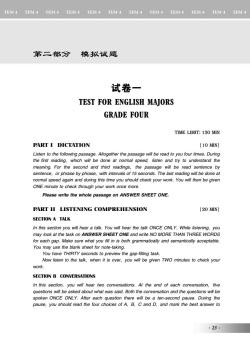
TEM4TEM4TEM4TEM4TEM4TEM4TEM4TEM4TEM4TEM4TEM4TEM4第二部分模拟试题试卷一TESTFORENGLISHMAIORSGRADEFOURTIMELIMIT:130MINPART I DICTATION[10 MIN]Listentothefollowingpassage.Altogetherthepassagewill bereadtoyoufourtimes.Duringthefirst reading, which will be done at normal speed,listen and try to understand themeaning.For the second and third readings,the passage will be read sentence bysentence, orphrasebyphrase,with intervalsof 15seconds.Thelastreadingwillbedoneatnormalspeedagainandduringthistimeyoushouldcheckyourwork.YouwillthenbegivenONEminute to check through your work once more.PleasewritethewholepassageonANSWERSHEETONEPART II LISTENING COMPREHENSION[20 MIN]SECTIONATALKIn this section you will hear atalk.You will hearthe talk ONCEONLY.While listening,youmaylookatthetaskonANSWERSHEETONEandwriteNOMORETHANTHREEWORDSforeachgap.Makesurewhatyoufill inisbothgrammaticallyandsemanticallyacceptableYoumayusetheblank sheetfornote-taking.YouhaveTHIRTY seconds topreviewthe gap-fillingtaskNowlistentothetalk,when it is over,youwill begivenTWOminutesto check yourwork.SECTIONBCONVERSATIONSIn this section,you will hear two conversations.At the end of each conversation, fivequestions will beasked about whatwas said.Boththe conversation andthequestionswillbespoken ONCE ONLY.After each question there will be a ten-second pause.During thepause, you should read the four choices of A, B, C and D, and mark the best answer to.23
!"# $ !"# $ !"# $ !"# $ !"# $ !"# $ !"# $ !"# $ !"# $ !"# $ !"# $ !"# $ !%#$ &'() (+, !"#! $%& "'()*#+ ,-.%&# (&-5" $%6& !"#$ %"#"!& '() #"* !"#$ % &%'$"$%() "') #"*# !"#$%&$'$(%)'**'+"&,-.##.,%/0*$',%$(%1$(%-.##.,%+"**2%1%.3$'4'5)'51$"6%#/751"&, $(%)"1#$1%.3"&,8+("9(+"**2%3'&%.$&'16.*#-%%38*"#$%&.&3$14 $'5&3%1#$.&3$(% 6%.&"&,/:'1$(% #%9'&3 .&3 $("13 1%.3"&,#8 $(% -.##.,% +"**2% 1%.3 #%&$%&9% 24 #%&$%&9%8'1-(1.#%24 -(1.#%8+"$("&$%1;.*# ')(%*.#$1%.3"&,+"**2%3'&%.$ &'16.*#-%%3.,."&.&3351"&,$("# $"6%4'5#('5*39(%9? 4'51+'1?/@'5+"**$(%&2%,";%& ABC6"&5$%$'9(%9? $(1'5,(4'51+'1? '&9%6'1%/ !"#$%#&'()#)*#&*+"#,$%%$-#+./01234153367038 !"#$ %% *%+$,)%)- '(.!#,/,)+%() "+) #"*# !"#$%&' ( $()* D&$("# #%9$"'&4'5+"**(%.1.$.*?/@'5+"**(%.1$(%$.*? ABECAB!@/F("*%*"#$%&"&,84'5 6.4 *''? .$$(%$.#? '&/0123415336703.&3+1"$%BAGAHC>I0B>IHCCFAH7J )'1%.9(,.-/G.?%#51%+(.$4'5)"**"&"# 2'$(,1.66.$"9.**4 .&3#%6.&$"9.**4 .99%-$.2*%/ @'56.4 5#%$(%2*.&? #(%%$)'1&'$%K$.?"&,/ @'5(.;%>IDH>@#%9'&3# $'-1%;"%+$(%,.-K)"**"&,$.#?/ B'+*"#$%&$'$(%$.*?8+(%&"$"# ';%184'5+"**2%,";%&>FA 6"&5$%# $'9(%9? 4'51 +'1?/ !"#$%&' + #&',"-!($%&'! D&$("# #%9$"'&84'5+"**(%.1$+' 9'&;%1#.$"'&#/0$$(%%&3')%.9( 9'&;%1#.$"'&8)";% L5%#$"'&# +"**2%.#?%3.2'5$+(.$+.# #."3/M'$($(%9'&;%1#.$"'&.&3$(%L5%#$"'&# +"**2% #-'?%&ABEC AB!@/0)$%1%.9(L5%#$"'&$(%1%+"**2%.$%&K#%9'&3-.5#%/751"&,$(% -.5#%84'5#('5*31%.3$(%)'519('"9%# ')08M8E.&378.&36.1? $(%2%#$.&#+%1$' !"#!
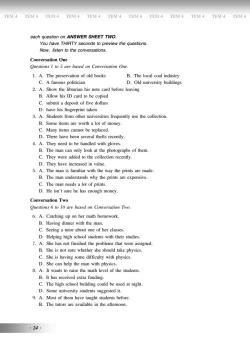
TEM4TEM4TEM4TEM4TEM4TEM4TEM4TEM4TEM4TEM4TEM4TEM4eachquestiononANSWERSHEETTWO.You have THIRTYseconds to previewthequestions.Now,listentotheconversations.Conversation OneQuestions I to 5 are based on Conversation One.1.A.The preservation of old booksB. The local coal industryC.AfamouspoliticianD. Old university buildings2.A. Show the librarian his note card before leavingB. Allow his ID card to be copiedC. submit a deposit of five dollarsD. have his fingerprint taken3.A.Students from other universitiesfrequently usethe collectionB.Some items are worth a lot of money.C.Many items cannot bereplaced.D.There have been several thefts recently4.A.TheyneedtobehandledwithglovesB.The man can only look at the photographs of themC.Theywere added to the collection recentlyD. They have increased in value.5.A.Themanisfamiliarwiththewaytheprintsaremade.B. The man understands why the prints are expensive.C. The man needs a lot of prints.D. He isn't sure he has enough money.Conversation TwoQuestions 6 to l0 are based on Conversation Two.6. A. Catching up on her math homework.B. Having dinner with the man.C. Seeing a tutor about one of her classes.D. Helping high school students with their studies.7.A.Shehas notfinished theproblemsthatwereassignedB. She is not sure whether she should take physics.C. She is having some difficulty with physicsD. She can help the man with physics.8.A.Itwantstoraisethemathlevel ofthe students.B. It has received extra funding.C. The high school building could be used at night.D. Some university students suggested it.9. A. Most of them have taught students before.B.Thetutorsareavailableintheafternoon·24
!"# $ !"# $ !"# $ !"# $ !"# $ !"# $ !"# $ !"# $ !"# $ !"# $ !"# $ !"# $ %.9(L5%#$"'&'&/0123415336627/ @'5(.;%>IDH>@#%9'&3# $'-1%;"%+$(%L5%#$"'&#/ B'+8*"#$%&$'$(%9'&;%1#.$"'&#/ %&'()*+,-.&'/') !"#$%&'($) %' * +,#-+$#. '( /'(0#,$+%&'( 1(#2 $%&%%\4/ B+67.-56(H ?B64/6+=5 @%&%E319(3.46?-*-6*+ 365+1(.)*-/ ?.01-.4.*76+= 8%&4419365'>)*-/ (1 ?.)1:6./ ;%5B?26(*/.:156(10067./144*-5 >%3*7.36506+=.-:-6+((*C.+ D%&%E(B/.+(50-12 1(3.-B+67.-56(6.50-.RB.+(4H B5.(3.)144.)(61+% 8%E12.6(.25*-.91-(3 *41(1021+.H% ;%V*+H 6(.25)*++1(?.-.:4*)./% >%%%P.65+,(5B-.3.3*5.+1B=3 21+.H% %&'()*+,-.&'!0& !"#$%&'($3 %' )4 +,#-+$#. '( /'(0#,$+%&'( 56'2 M%&%;*()36+= B: 1+ 3.-2*(3 312.91-C% 8%P*76+= /6++.-96(3 (3.2*+% ;%E.6+= *(B(1-*?1B(1+.103.-)4*55.5% >%P.4:6+= 36=3 5)31145(B/.+(596(3 (3.6-5(B/6.5% N%&%E3.3*5+1(06+653./ (3.:-1?4.25(3*(9.-.*556=+./% 8%E3.65+1(5B-.93.(3.-53.531B4/ (*C.:3H56)5% ;%E3.653*76+= 512./6006)B4(H 96(3 :3H56)5% >%E3.)*+ 3.4: (3.2*+ 96(3 :3H56)5% I%&%'(9*+(5(1 -*65.(3.2*(3 4.7.410(3.5(B/.+(5% 8%'(3*5-.).67./ .F(-*0B+/6+=% ;%%E12.B+67.-56(H 5(B/.+(55B==.5(./ 6(% S%&%V15(10(3.2 3*7.(*B=3(5(B/.+(5?.01-.% 8%<3.(B(1-5*-.*7*64*?4.6+ (3.*0(.-+11+% !"$!
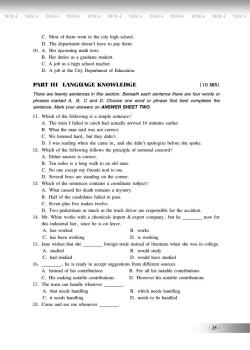
TEM4TEM4TEM4TEM4TEM4TEM4TEM4TEM4TEM4TEM4TEM4TEM4C.Most of them went to the city high school.D. The department doesn't have to pay them.10.A.Her upcoming math tests.B. Her duties as a graduate student.C. A job as a high school teacher.D. A job at the City Department of Education.PARTIIILANGUAGEKNOWLEDGE[10 MIN]There are twenty sentences in this section.Beneath each sentence there are four words orphrases marked A, B, C and D. Choose one word or phrase that best completes thesentence.MarkyouranswersonANSWERSHEETTWOIl.Which of the following is a simple sentence?A.The train I failed to catch had actually arrived 10 minutes earlier.B.Whattheman said was notcorrect.C. We listened hard, but they didn't.D.I was reading when she came in, and she didn't apologize before she spoke.12.Which of the following follows the principleof notional concord?A. Either answer is correct.B.Tenmilesisalongwalktoanoldman.C. No one except my friends nod to me.D. Several boys are standing on the corner.13.Which of the sentences containsa coordinatesubject?A. What caused his death remains a mystery.B. Half of the candidates failed to pass.C. Seven plus five makes twelve.D.Twopedestrians as muchasthetruckdriver areresponsiblefortheaccident.14.Mr.Whiteworkswith a chemicals import&export company,buthenow forthis industrial fair, since he is on leave.A. has workedB. worksC. has been workingD.is working15.Janewishesthatsheforeign trade instead of literature when she was in college.A. studiedB. would studyC.had studiedD.would have studied16.,he is readytoaccept suggestionsfrom different sources.A.Instead of his contributionsB.For all his notable contributionsC.His making notable contributionsD.Howeverhis notable contributions17.The team can handle whateverA. that needs handlingB. which needs handlingC. it needs handlingD. needs to be handled18.Comeand seemewhenever.25
!"# $ !"# $ !"# $ !"# $ !"# $ !"# $ !"# $ !"# $ !"# $ !"# $ !"# $ !"# $ ;%V15(10(3.29.+((1 (3.)6(H 36=3 5)3114% >%%&[1? *((3.;6(H >.:*-(2.+(10Y/B)*(61+% !"#$ %%% *")-0"-, 1)(2*,&-, "') #"*# >(%1%.1%$+%&$4 #%&$%&9%# "&$("# #%9$"'&/M%&%.$(%.9(#%&$%&9%$(%1%.1%)'51+'13# '1 -(1.#%# 6.1?%308M8E .&37/E(''#%'&%+'13'1-(1.#%$(.$2%#$9'6-*%$%# $(% #%&$%&9%/G.1? 4'51.&#+%1# '&/0123415336627/ $$%Q36)3 10(3.0144196+= 65*562:4.5.+(.+).) &%%'9*5-.*/6+= 93.+ 53.)*2.6+" *+/ 53./6/+,(*:141=6W.?.01-.53.5:1C.% $@%Q36)3 10(3.0144196+= 0144195(3.:-6+)6:4.10+1(61+*4)1+)1-/) &%Y6(3.-*+59.-65)1-.)(% 8%%E.7.-*4?1H5*-.5(*+/6+= 1+ (3.)1-+.-% $D%Q36)3 10(3.5.+(.+).5)1+(*6+5*)11-/6+*(.5B?[.)() &%Q3*()*B5./ 365/.*(3 -.2*6+5*2H5(.-H% 8%P*4010(3.)*+/6/*(.50*64./ (1 :*55% ;%E.7.+ :4B5067.2*C.5(9.47.% >%%6591-C6+= $L%b*+.9653.5(3*(53. 01-.6=+ (-*/.6+5(.*/ 1046(.-*(B-.93.+ 53.9*56+ )144.=.% &%5(B/6./ 8%91B4/ 5(B/H ;%3*/ 5(B/6./ >%91B4/ 3*7.5(B/6./ $M% " 3.65-.*/H (1 *)).:(5B==.5(61+50-12 /600.-.+(51B-).5% &%'+5(.*/ 10365)1+(-6?B(61+5 8%U1-*44365+1(*?4.)1+(-6?B(61+5 ;%P652*C6+= +1(*?4.)1+(-6?B(61+5 >%P19.7.-365+1(*?4.)1+(-6?B(61+5 $N%%+./5(1 ?.3*+/4./ $I%;12.*+/ 5.2.93.+.7.- % !"1!
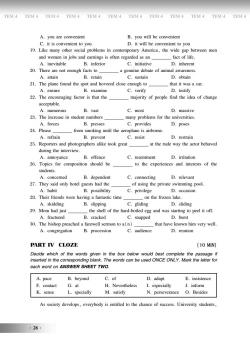
TEM4TEM4TEM4TEM4TEM4TEM4TEM4TEM4TEM4TEM4TEM4TEM4A. you are convenientB. you will be convenientC.it is convenientto youD. it will be convenient to you19.Likemanyother social problems in contemporary America,the wide gap betweenmenand women in jobsand earnings is oftenregardedas anfact of life.D. inherentA.inevitableB.inferiorC.initiative20.There are not enough facts toa genuine debate of animal awareness.B. retainC. sustainA. attainD. obtain21.Theplane found the spotand hovered closeenough tothat it was a car.A. ensureB.examineC. verifyD. testify22.The encouraging factor is that themajority of people find the idea of changeacceptable.B. vastC. mostD. massiveA.numerous23.Theincreasein studentnumbersmany problems for the universities.B. pressesC. providesA. forcesD. poses24.Pleasefrom smokinguntiltheaeroplaneisairborneA.refrainC.resistD. restrainB. prevent25. Reporters and photographers alike took greatat the rude way the actor behavedduring the interview.B.offenceC. resentmentD. irritationA.annoyance26. Topics for composition should beto the experiences and interests of thestudents.B. dependentA.concernedC.connectingD. relevant27.They said onlyhotel guestshad theof using the private swimming pool.B. possibilityC. privilegeD.occasionA. habit28.Their friends were having a fantastic timeon the frozen lake.C. glidingA. skiddingB. slippingD. sliding29. Mom had justthe shell of the hard-boiled egg and was starting to peel it off.B. crackedC. snappedA.fracturedD. burst30.The bishop preached a farewell sermon to a(n)that haveknownhimverywell.C. audienceD. reunionA.congregationB.processionPART IVCLOZE[10 MIN]Decidewhichof the wordsqiveninthe boxbelow wouldbestcompletethepassage ifinserted inthecorrespondingblank.ThewordscanbeusedONCEONLY.MarktheletterforeachwordonANSWERSHEETTWO.C. ofA.paceB.beyondD. adaptE.insistenceF.contactG. atH. NeverthelessI. especiallyJ. informL, speciallyK.senseM.satisfyN.perseveranceO.BesidesAs society develops, everybody is entitled to the chance of success. University students,·26
!"# $ !"# $ !"# $ !"# $ !"# $ !"# $ !"# $ !"# $ !"# $ !"# $ !"# $ !"# $ &%H1B *-.)1+7.+6.+( 8%H1B 9644?.)1+7.+6.+( ;%6(65)1+7.+6.+((1 H1B >%6(9644?.)1+7.+6.+((1 H1B $S%^6C.2*+H 1(3.-51)6*4:-1?4.256+ )1+(.2:1-*-H &2.-6)*" (3.96/.=*: ?.(9.+ 2.+ *+/ 912.+ 6+ [1?5*+/ .*-+6+=56510(.+ -.=*-/./ *5*+ 0*)(10460.% &%6+.76(*?4. 8%6+0.-61- ;%6+6(6*(67. >%6+3.-.+( @K%%1?(*6+ @$%%(.5(60H @@%%2*5567. @D%%:15.5 @G%Z4.*5. 0-12521C6+= B+(64(3.*.-1:4*+.65*6-?1-+.% &%-.0-*6+ 8%:-.7.+( ;%-.565( >%-.5(-*6+ @L%X.:1-(.-5*+/ :31(1=-*:3.-5*46C.(11C =-.*( *((3.-B/.9*H (3.*)(1-?.3*7./ /B-6+= (3.6+(.-76.9% &%*++1H*+). 8%100.+). ;%-.5.+(2.+( >%6-6(*(61+ @M%%-.4.7*+( @N%%1))*561+ @I%%546/6+= @S%V12 3*/ [B5( (3.53.4410(3.3*-/!?164./ .== *+/ 9*55(*-(6+= (1 :.46(100% &%0-*)(B-./ 8%)-*)C./ ;%5+*::./ >%?B-5( DK%%-.B+61+ !"#$ %3 '*(4, "') #"*# 7%9"3%+("9(')$(%+'13# ,";%&"&$(%2'N 2%*'+ +'5*32%#$9'6-*%$%$(%-.##.,%") "&#%1$%3"&$(%9'11%#-'&3"&,2*.&?/>(%+'13# 9.&2%5#%3ABECAB!@/G.1? $(%*%$$%1)'1 %.9(+'13'&/0123415336627/ &%:*).aaa8%?.H1+/ aaa;%10aaa >%*/*:(aaaaY%6+565(.+). U%)1+(*)( A%*( P%T.7.-(3.4.55 '%.5:.)6*44H b%6+01-2 c%5.+5. ^%5:.)6*44H V%5*(650H T%:.-5.7.-*+). \%8.56/.5 &551)6.(H /.7.41:5" .7.-H?1/H 65.+(6(4./ (1 (3.)3*+).105B)).55%]+67.-56(H 5(B/.+(5" !"2!
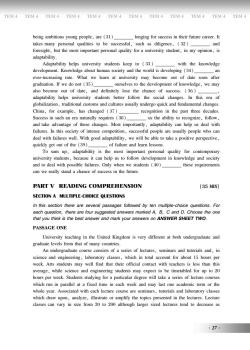
TEM4TEM4TEM4TEM4TEM4TEM4TEM4TEM4TEM4TEM4TEM4TEM4beingambitious youngpeople,are(31)longing for success in their future career.Itandtakesmanypersonal qualities tobe successful,such as diligence,(32)foresight, but the most important personal quality for a university student, in my opinion, isadaptabilitywiththeknowledgeAdaptability helps university students keep in (33)development.Knowledge about human society and the world is developing (34)anever-increasing rate.What we learn at university may become out of date soon aftergraduation.If wedo not (35)ourselves to the development ofknowledge, we mayalso become out of date,and definitely lose the chance of success.(36)adaptability helps university students better follow the social changes. In this era ofglobalization,traditional customs and cultures usually undergo quick and fundamental changes.China,for example,haschanged(37)recognition in the past three decades.Successinsuch an era naturallyrequires (38)us the abilityto recognize,follow,and take advantage of these changes.Most importantly,adaptability can help us deal withfailures.In this society of intense competition,successful people are usually people who candeal with failures well.With good adaptability,we will be able to take a positive perspective,quickly get out of the (39)offailureandlearnlessons.To sum up,adaptability is the most important personal quality for contemporaryuniversity students,because it canhelp us to followdevelopmentin knowledge and societyand to deal with possible failures. Only when we students (40)theserequirementscan we really stand a chance of success in the futurePARTV READINGCOMPREHENSION[35 MIN]SECTIONA MULTIPLE-CHOICEQUESTIONSIn this section there are several passages followed byten multiple-choice questions.Foreach question, there are four suggested answers marked A, B, C and D. Choose the onethatyouthinkisthebestanswerandmarkyouranswersonANSWERSHEETTWO.PASSAGE ONEUniversityteachingin the United Kingdomis very different atboth undergraduate andgraduate levels from that of many countries.An undergraduate course consists of a series of lectures, seminars and tutorials and,inscience and engineering,laboratory classes,which in total account for about l5 hours perweek.Arts students may well find that their official contact with teachers is less than thisaverage,while science and engineering students may expect to be timetabled for up to 20hours per week. Students studying for a particular degree will take a series of lecture courseswhich run in parallel at a fixed time in each week and may last one academic term or thewhole year.Associated with each lecture course are seminars,tutorials and laboratory classeswhich draw upon,analyze,illustrate or amplify the topics presented in the lectures.Lectureclassescanvaryin size from20 to 200 although largersizedlecturestendto decreaseas.27
!"# $ !"# $ !"# $ !"# $ !"# $ !"# $ !"# $ !"# $ !"# $ !"# $ !"# $ !"# $ ?.6+= *2?6(61B5H1B+= :.1:4." *-.'D$( 41+=6+= 01-5B)).556+ (3.6-0B(B-.)*-.-%'( (*C.52*+H :.-51+*4RB*46(6.5(1 ?.5B)).550B4" 5B)3 *5/646=.+)." ' D@ ( *+/ 01-.56=3(" ?B((3.215(62:1-(*+(:.-51+*4RB*46(H 01-*B+67.-56(H 5(B/.+(" 6+ 2H 1:6+61+" 65 */*:(*?646(H% &/*:(*?646(H 3.4:5B+67.-56(H 5(B/.+(5C.: 6+ ' DD ( 96(3 (3. C+194./=. /.7.41:2.+(%c+194./=.*?1B(3B2*+ 51)6.(H *+/ (3.91-4/ 65/.7.41:6+= 'DG( *+ .7.-!6+)-.*56+= -*(.%Q3*(9.4.*-+ *(B+67.-56(H 2*H ?.)12. 1B(10/*(.511+ *0(.- =-*/B*(61+%'09./1 +1('DL( 1B-5.47.5(1 (3./.7.41:2.+(10C+194./=." 9.2*H *451 ?.)12. 1B(10/*(." *+/ /.06+6(.4H 415.(3.)3*+). 105B)).55%' DM ( " */*:(*?646(H 3.4:5 B+67.-56(H 5(B/.+(5 ?.((.-014419 (3. 51)6*4)3*+=.5%'+ (365.-* 10 =41?*46W*(61+" (-*/6(61+*4)B5(125*+/ )B4(B-.5B5B*44H B+/.-=1 RB6)C *+/ 0B+/*2.+(*4)3*+=.5% ;36+*" 01-.F*2:4." 3*5)3*+=./ ' DN ( -.)1=+6(61+ 6+ (3.:*5((3-./.)*/.5% EB)).556+ 5B)3 *+ .-*+*(B-*44H -.RB6-.5'DI( B5(3.*?646(H (1 -.)1=+6W." 014419" *+/ (*C.*/7*+(*=.10(3.5.)3*+=.5%V15(62:1-(*+(4H" */*:(*?646(H )*+ 3.4: B5/.*496(3 0*64B-.5%'+ (36551)6.(H 106+(.+5.)12:.(6(61+" 5B)).550B4:.1:4.*-.B5B*44H :.1:4.931 )*+ /.*496(3 0*64B-.59.44%Q6(3 =11/ */*:(*?646(H" 9.9644?.*?4.(1 (*C.*:156(67.:.-5:.)(67." RB6)C4H =.(1B(10(3.'DS( 100*64B-.*+/ 4.*-+ 4.551+5% <1 5B2 B:" */*:(*?646(H 65(3.215(62:1-(*+(:.-51+*4RB*46(H 01-)1+(.2:1-*-H B+67.-56(H 5(B/.+(5" ?.)*B5.6()*+ 3.4: B5(1 014419 /.7.41:2.+(6+ C+194./=.*+/ 51)6.(H *+/ (1 /.*496(3 :1556?4.0*64B-.5%\+4H 93.+ 9.5(B/.+(5'GK( (3.5.-.RB6-.2.+(5 )*+ 9.-.*44H 5(*+/ *)3*+).105B)).556+ (3.0B(B-.% !"#$ 3 #,"&%)- '(.!#,/,)+%() "(, #"*# !"#$%&' ( ./)$%0)"!#1&%#" 2/"!$%&'! D&$("# #%9$"'&$(%1%.1%#%;%1.*-.##.,%# )'**'+%324 $%&65*$"-*%K9('"9%L5%#$"'&#/:'1 %.9(L5%#$"'&8$(%1%.1%)'51#5,%#$%3.&#+%1# 6.1?%308M8E.&37/E(''#%$(%'&% $(.$4'5$("&? "# $(%2%#$.&#+%1.&36.1? 4'51.&#+%1# '&/0123415336627/ 123324"/5" ]+67.-56(H (.*)36+= 6+ (3.]+6(./ c6+=/12 657.-H /600.-.+(*(?1(3 B+/.-=-*/B*(.*+/ =-*/B*(.4.7.450-12(3*(102*+H )1B+(-6.5% &+ B+/.-=-*/B*(.)1B-5.)1+565(510*5.-6.5104.)(B-.5" 5.26+*-5*+/ (B(1-6*45*+/" 6+ 5)6.+).*+/ .+=6+.-6+=" 4*?1-*(1-H )4*55.5" 936)3 6+ (1(*4*))1B+(01-*?1B($L 31B-5:.- 9.C%&-(55(B/.+(52*H 9.4406+/ (3*((3.6-1006)6*4)1+(*)(96(3 (.*)3.-5654.55(3*+ (365 *7.-*=." 9364.5)6.+).*+/ .+=6+.-6+= 5(B/.+(52*H .F:.)((1 ?.(62.(*?4./ 01-B: (1 @K 31B-5:.-9.C%E(B/.+(55(B/H6+= 01-*:*-(6)B4*-/.=-.9644(*C.*5.-6.5104.)(B-.)1B-5.5 936)3 -B+ 6+ :*-*44.4*(*06F./ (62.6+ .*)3 9.C *+/ 2*H 4*5(1+.*)*/.26)(.-2 1-(3. 9314.H.*-%&551)6*(./ 96(3 .*)3 4.)(B-.)1B-5.*-.5.26+*-5" (B(1-6*45*+/ 4*?1-*(1-H )4*55.5 936)3 /-*9 B:1+" *+*4HW." 644B5(-*(.1-*2:460H (3.(1:6)5:-.5.+(./ 6+ (3.4.)(B-.5%^.)(B-. )4*55.5)*+ 7*-H 6+ 56W.0-12 @K (1 @KK *4(31B=3 4*-=.-56W./ 4.)(B-.5(.+/ (1 /.)-.*5.*5 !"3!
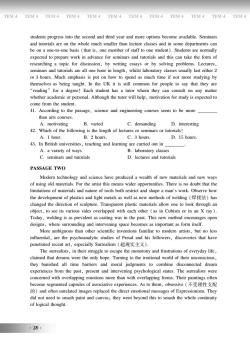
TEM4TEM4TEM4TEM4TEM4TEM4TEM4TEM4TEM4TEM4TEM4TEM4students progress into the second and third year and more options become available.Seminarsand tutorials are on the whole much smaller than lecture classes and in some departments canbe on a one-to-onebasis(that is,onemember of staff to one student).Students are normallyexpected to prepare work in advance for seminars and tutorials and this can take the form ofresearching a topic for discussion,bywriting essays or by solving problems.Lecturesseminars and tutorialsare all onehour in length,whilstlaboratory classes usuallylast either2or 3 hours. Much emphasis is put on how to spend as much time if not more studying bythemselves as being taught. In the UK it is still common for people to say that they are"reading"for a degree!Each student has a tutor whom they can consult on any matterwhether academic or personal.Although the tutor will help,motivationfor study is expected tocomefromthe student.4l.According to thepassage,science and engineering courses seem to be morethan arts courses.B. variedC. demandingD. interestingA.motivating42. Which of the following is the length of lectures or seminars or tutorials?A. 1hour.B. 2 hours.C. 3hours.D.15hours43.In British universities, teaching and learning are carried out inA.avarietyofwaysB.laboratoryclassesC.seminarsandtutorialsD.lectures and tutorialsPASSAGE TWOModern technology and science have produced a wealth of new materials and new waysof usingold materials.For theartist thismeanswider opportunities.Thereis no doubtthat thelimitationsofmaterialsandnatureoftoolsbothrestrictandshapeaman'sworkObservehowthe developmentof plastics and light metals as well as newmethods of welding(焊接法)haschanged the direction of sculpture.Transparent plastic materials allow one to look through anobject, to see its various sides overlapped with each other (as in Cubism or in an X ray).Today,welding is as prevalentascasting was in thepast.This newmethod encourages opendesigns,where surrounding and intervening space becomes as important as form itself.Moreambiguousthan other scientificinventionsfamiliartomodern artists,butnolessinfluential, are the psychoanalytic studies of Freud and his followers,discoveries that havepenetratedrecentart,especiallySurrealism(超现实主义).The surrealists, in their struggle to escape the monotony and frustrations of everyday life,claimed that dreams were the only hope. Turning to the irational world of their unconscious,they banished all time barriers and moral judgments to combinedisconnected dreamexperiences from the past,present and intervening psychological states.The surrealists wereconcerned with overlapping emotionsmorethanwith overlappingforms.Theirpaintings oftenbecomesegmentedcapsulesofassociativeexperiences.Astothem,obsessive(不受理性支配的)and often unrelated images replaced the directemotional messages of Expressionism.Theydid not need to smash paint and canvas; they went beyond this to smash the whole continuityof logical thought.·28
!"# $ !"# $ !"# $ !"# $ !"# $ !"# $ !"# $ !"# $ !"# $ !"# $ !"# $ !"# $ 5(B/.+(5:-1=-.556+(1 (3.5.)1+/ *+/ (36-/ H.*-*+/ 21-.1:(61+5?.)12.*7*64*?4.%E.26+*-5 *+/ (B(1-6*45*-.1+ (3.9314.2B)3 52*44.-(3*+ 4.)(B-.)4*55.5*+/ 6+ 512./.:*-(2.+(5)*+ ?.1+ *1+.!(1!1+.?*565'(3*(65" 1+.2.2?.-105(*00(1 1+.5(B/.+((%E(B/.+(5*-.+1-2*44H .F:.)(./ (1 :-.:*-.91-C 6+ */7*+).01-5.26+*-5*+/ (B(1-6*45*+/ (365)*+ (*C.(3.01-2 10 -.5.*-)36+= *(1:6)01-/65)B5561+" ?H 9-6(6+= .55*H51-?H 51476+= :-1?4.25%^.)(B-.5" 5.26+*-5*+/ (B(1-6*45*-.*441+.31B-6+ 4.+=(3" 93645(4*?1-*(1-H )4*55.5B5B*44H 4*5(.6(3.-@ 1-D 31B-5%VB)3 .2:3*56565:B(1+ 319 (1 5:.+/ *52B)3 (62.60+1(21-.5(B/H6+= ?H (3.25.47.5*5?.6+= (*B=3(%'+ (3.]c 6(655(644)1221+ 01-:.1:4.(1 5*H (3*((3.H *-. $-.*/6+=% 01-*/.=-.+ Y*)3 5(B/.+(3*5*(B(1-9312 (3.H )*+ )1+5B4(1+ *+H 2*((.- 93.(3.-*)*/.26)1-:.-51+*4%&4(31B=3 (3.(B(1-96443.4:" 21(67*(61+ 01-5(B/H 65.F:.)(./ (1 )12.0-12(3.5(B/.+(% G$%&))1-/6+= (1 (3.:*55*=." 5)6.+).*+/ .+=6+.-6+= )1B-5.55.2 (1 ?.21-. (3*+ *-(5)1B-5.5% &%21(67*(6+= 8%7*-6./ ;%/.2*+/6+= >%6+(.-.5(6+= G@%Q36)3 10(3.0144196+= 65(3.4.+=(3 104.)(B-.51-5.26+*-51-(B(1-6*45) &%$ 31B-% 8%@ 31B-5% ;%D 31B-5% >%$L 31B-5% GD%'+ 8-6(653 B+67.-56(6.5" (.*)36+= *+/ 4.*-+6+= *-.)*-6./ 1B(6+ % &%*7*-6.(H 109*H5 8%4*?1-*(1-H )4*55.5 ;%5.26+*-5*+/ (B(1-6*45 >%4.)(B-.5*+/ (B(1-6*45 123324"!6/ V1/.-+ (.)3+141=H *+/ 5)6.+).3*7.:-1/B)./ *9.*4(3 10+.92*(.-6*45*+/ +.99*H5 10B56+= 14/ 2*(.-6*45%U1-(3.*-(65((3652.*+596/.-1::1-(B+6(6.5%<3.-.65+1 /1B?((3*((3. 4626(*(61+5102*(.-6*45*+/ +*(B-.10(1145?1(3 -.5(-6)(*+/ 53*:.*2*+,591-C%\?5.-7.319 (3./.7.41:2.+(10:4*5(6)5*+/ 46=3(2.(*45*59.44*5+.92.(31/5109.4/6+= ')*+( 3*5 )3*+=./ (3./6-.)(61+ 105)B4:(B-.%<-*+5:*-.+(:4*5(6)2*(.-6*45*4419 1+.(1 411C (3-1B=3 *+ 1?[.)(" (1 5.6(57*-61B556/.517.-4*::./ 96(3 .*)3 1(3.-'*56+ ;B?652 1-6+ *+ e -*H(% <1/*H" 9.4/6+= 65*5:-.7*4.+(*5)*5(6+= 9*56+ (3.:*5(%<365+.92.(31/ .+)1B-*=.51:.+ /.56=+5" 93.-.5B-1B+/6+= *+/ 6+(.-7.+6+= 5:*).?.)12.5*562:1-(*+(*501-26(5.40% V1-.*2?6=B1B5(3*+ 1(3.-5)6.+(606)6+7.+(61+50*2646*-(1 21/.-+ *-(65(5" ?B(+1 4.55 6+04B.+(6*4" *-.(3.:5H)31*+*4H(6)5(B/6.510U-.B/ *+/ 365014419.-5" /65)17.-6.5(3*(3*7. :.+.(-*(./ -.).+(*-(" .5:.)6*44H EB-.*4652',-./0(% <3.5B-.*465(5" 6+ (3.6-5(-B==4.(1 .5)*:.(3.21+1(1+H *+/ 0-B5(-*(61+510.7.-H/*H 460." )4*62./ (3*(/-.*259.-.(3.1+4H 31:.%<B-+6+= (1 (3.6-*(61+*491-4/ 10(3.6-B+)1+5)61B5" (3.H ?*+653./ *44(62. ?*-6.-5*+/ 21-*4[B/=2.+(5(1 )12?6+. /65)1++.)(./ /-.*2 .F:.-6.+).50-12 (3.:*5(" :-.5.+(*+/ 6+(.-7.+6+= :5H)3141=6)*45(*(.5%<3.5B-.*465(59.-. )1+).-+./ 96(3 17.-4*::6+= .21(61+521-.(3*+ 96(3 17.-4*::6+= 01-25%<3.6-:*6+(6+=510(.+ ?.)12.5.=2.+(./ )*:5B4.510*551)6*(67.F:.-6.+).5%&5(1 (3.2" 1?5.5567.'123456 #( *+/ 10(.+ B+-.4*(./ 62*=.5-.:4*)./ (3./6-.)(.21(61+*42.55*=.510YF:-.5561+652%<3.H /6/ +1(+./ (1 52*53 :*6+(*+/ )*+7*5& (3.H 9.+(?.H1+/ (365(1 52*53 (3.9314.)1+(6+B6(H 1041=6)*4(31B=3(% !"4!
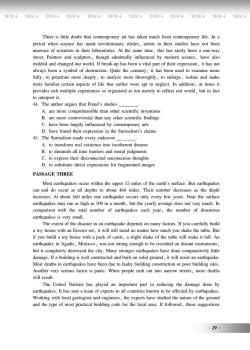
TEM4TEM4TEM4TEM4TEM4TEM4TEM4TEM4TEM4TEM4TEM4TEM4There is little doubt that contemporary art has taken much from contemporary life.In aperiod when science has made revolutionary strides, artists in their studios have not beenunawareof scientistsintheirlaboratories.Atthe sametime,this has rarelybeena one-waystreet. Painters and sculptors, though admittedly influenced by modern science, have alsomolded and changed our world.If break-up hasbeen a vital partof their expression,it has notalways been a symbol of destruction.Quite the contrary: it has been used to examine morefully,to penetrate more deeply,to analyze more thoroughly,to enlarge,isolate and makemorefamiliar certain aspectsof life that earlier wereaptto neglect.Inaddition,attimes itprovidesrichmultiple experiencesso organized as notmerelyto reflect our world,butin factto interpretit.44.The author argues that Freud's studiesA.aremorecomprehensiblethan otherscientific inventionsB.are more controversial than any other scientific findingsC.have been largely influenced by contemporary artsD. have found their expression in the Surrealism's claims45.TheSurrealismmadeeveryendeavorA.totransformrealexistenceintoincoherentdreamsB. to diminish all time barriers and moral judgmentsC.toexpresstheirdisconnectedunconsciousthoughtsD.to substitute direct expressions for fragmented imagesPASSAGETHREEMost earthquakes occur within the upper 15 miles of the earth's surface. But earthquakescan and do occur at all depthsto about460 miles.Their number decreases as thedepthincreases.Atabout460 miles oneearthquake occurs onlyeveryfew years.Near thesurfaceearthquakesmayrun ashigh asloo in a month,but theyearlyaveragedoes not varymuch.Incomparison with thetotal number of earthquakes each year,the number of disastrousearthquakes is very small.The extent of the disaster in an earthquake depends on many factors. If you carefully builda toyhousewithan Erector set,itwill still stand nomatterhowmuchyou shakethetable.Butif you build a toy house with a pack of cards, a slight shake of the table will make it fall. Anearthquake in Agadir,Moroccowas notstrong enoughtoberecorded on distantinstruments.but it completely destroyed the city.Many stronger earthquakes have done comparatively littledamage.If a building is well constructed and built on solid ground,it will resist an earthquakeMost deaths in earthquakes have been dueto faulty building construction or poor building sitesAnother very seriousfactorispanic.Whenpeoplerush outinto narrow streets,moredeathswill result.The United Nations has played an important part in reducing the damage done byearthquakes.It has sent a team of experts to all countriesknown to be affected byearthquakesWorking with local geologists and engineers, the experts have studied the nature of the groundand the type of most practical building codefor the local area.Iffollowed, these suggestions.29
!"# $ !"# $ !"# $ !"# $ !"# $ !"# $ !"# $ !"# $ !"# $ !"# $ !"# $ !"# $ %3*7.01B+/ (3.6-.F:-.5561+ 6+ (3.EB-.*4652,5)4*625 GL%%(1 5B?5(6(B(./6-.)(.F:-.5561+501-0-*=2.+(./ 62*=.5 123324"!78"" V15(.*-(3RB*C.51))B-96(36+ (3.B::.-$L 264.510(3.*-(3,55B-0*).%8B(.*-(3RB*C.5 )*+ *+/ /1 1))B-*(*44/.:(35(1 *?1B(GMK 264.5%<3.6-+B2?.-/.)-.*5.5*5(3./.:(3 6+)-.*5.5%&(*?1B(GMK 264.51+.*-(3RB*C.1))B-51+4H .7.-H 0.9 H.*-5%T.*-(3.5B-0*). .*-(3RB*C.52*H -B+ *536=3 *5$KK 6+ *21+(3" ?B((3.H.*-4H *7.-*=./1.5+1(7*-H 2B)3%'+ )12:*-651+ 96(3 (3.(1(*4+B2?.-10.*-(3RB*C.5.*)3 H.*-" (3. +B2?.-10/65*5(-1B5 .*-(3RB*C.5657.-H 52*44% <3.F(.+(10(3./65*5(.-6+ *+ .*-(3RB*C./.:.+/51+ 2*+H 0*)(1-5%'0H1B )*-.0B44H ?B64/ *(1H 31B5.96(3 *+ Y-.)(1-5.(" 6(96445(6445(*+/ +1 2*((.-3192B)3 H1B 53*C.(3.(*?4.%8B( 60H1B ?B64/ *(1H 31B5.96(3 *:*)C 10)*-/5" *546=3(53*C.10(3.(*?4.96442*C.6(0*44%&+ .*-(3RB*C.6+ &=*/6-" V1-1))1" 9*5+1(5(-1+= .+1B=3 (1 ?.-.)1-/./ 1+ /65(*+(6+5(-B2.+(5" ?B(6()12:4.(.4H /.5(-1H./ (3.)6(H%V*+H 5(-1+=.-.*-(3RB*C.53*7./1+.)12:*-*(67.4H 46((4. /*2*=.%'0*?B64/6+= 659.44)1+5(-B)(./ *+/ ?B64(1+ 5146/ =-1B+/" 6(9644-.565(*+ .*-(3RB*C.% V15(/.*(356+ .*-(3RB*C.53*7.?.+ /B.(1 0*B4(H ?B64/6+= )1+5(-B)(61+ 1-:11-?B64/6+= 56(.5% &+1(3.-7.-H 5.-61B50*)(1-65:*+6)%Q3.+ :.1:4.-B53 1B(6+(1 +*-195(-.(5" 21-./.*(35 9644-.5B4(% <3.]+6(./ T*(61+53*5:4*H./ *+ 62:1-(*+(:*-(6+ -./B)6+= (3./*2*=./1+.?H .*-(3RB*C.5%'(3*55.+(*(.*2 10.F:.-(5(1 *44)1B+(-6.5C+19+ (1 ?.*00.)(./ ?H .*-(3RB*C.5% Q1-C6+= 96(3 41)*4=.141=65(5*+/ .+=6+.-5" (3.F:.-(53*7.5(B/6./ (3.+*(B-.10(3.=-1B+/ *+/ (3.(H:.10215(:-*)(6)*4?B64/6+= )1/.01-(3.41)*4*-.*%'0014419./" (3.5.5B==.5(61+5 !"A!

TEM4TEM4TEM4TEM4TEM4TEM4TEM4TEM4TEM4TEM4TEM4TEM4will make disastrous earthquakes almost a thing of the past.There is one type of earthquake disaster that little can be done about.This is the disastercaused byseismic sea waves,ortsunamis.(These are often calledtidal waves,butthenameis incorrect.They have nothing to do with tides.)In certain areas,earthquakes take placebeneaththe sea.These submarine earthquakes sometimes give rise to seismic sea waves.Thewaves are not noticeable out at sea because of their long wave length.But when they roll intoharbors,they pile up into walls of water 6to 60 feet high.The Japanesecall them"tsunamis",meaning"harbor waves",because theyreach a sizableheight onlyinharbors.Tsunamis travel fairly slowly,at speeds up to 500 miles an hour.An adequate warningsystem is in use to warn all shores likely to be reached by the waves. But this only enablespeople to leave the threatened shores for higher ground.There is no wayto stop the oncomingwave.46.Which of the following CANNOTbe concluded from thepassage?A. The number of earthquakes is closely related to depth.B.Roughlythe samenumberof earthquakes occur eachyearC.Earthquakesareimpossibleatdepthsover460miles.D.Earthquakes are most likely to occur near the surfaces.47.The destruction of Agadir is an example ofB. an earthquake's strengthA.faultybuilding constructionC. widespread panic in earthquakesD. ineffective instruments48.The United Nations'experts are supposed toA.construct strong buildingsB. put forward proposalsC.detect disastrous earthquakesD.monitor earthquakesPASSAGEFOUROne of the good things for men in women's liberation is that men no longer have to paywomentheold-fashionedcourtesiesInanarticleonthenewmanners,Ms.Holmes saysthataperfectlyablewomannolongerhasto acthelplessly inpublic as if she werea model.For example,shedoesn'tneed helpgetting in and out of cars.“Women get in and out of cars twenty times a day with babies anddogs. Surely they can get out by themselves at night just as easily.'She also says there is no reason why a man should walk on the outside of a woman on thesidewalk. "Historically, the man walked on the inside so he caught the garbage thrown out ofa window.Today a man is supposed to walk on the outside.A man should walk where hewants to.So should awoman.If.out of loveand respect,heactually wants to taketheblows,he should walk onthe insidebecause that's where attackers are all hiding thesedays."As far as manners are concerned,I suppose I have always been a supporter of women'sliberation.Over theyears,out of a sense of respect,Iimagine,Ihaverefusedto troublewomen with outdated courtesies.It is usually easier to follow rules of social behavior than to depend on one's own tasteBut rules maybe safelybroken,of course,bythoseof uswiththegift of natural grace.For·30
!"# $ !"# $ !"# $ !"# $ !"# $ !"# $ !"# $ !"# $ !"# $ !"# $ !"# $ !"# $ 96442*C./65*5(-1B5.*-(3RB*C.5*4215(*(36+= 10(3.:*5(% %Y*-(3RB*C.5*-.215(46C.4H (1 1))B-+.*-(3.5B-0*).5% GN%%6+.00.)(67.6+5(-B2.+(5 GI%%21+6(1-.*-(3RB*C.5 123324"K/L8 \+.10(3.=11/ (36+=501-2.+ 6+ 912.+,546?.-*(61+ 65(3*(2.+ +1 41+=.-3*7.(1 :*H 912.+ (3.14/!0*5361+./ )1B-(.56.5% '+ *+ *-(6)4.1+ (3.+.92*++.-5" V5%P142.55*H5(3*(*:.-0.)(4H *?4.912*+ +1 41+=.- 3*5(1 *)(3.4:4.554H 6+ :B?46)*56053.9.-.*21/.4%U1-.F*2:4." 53./1.5+,(+./ 3.4: =.((6+= 6+ *+/ 1B(10)*-5%$Q12.+ =.(6+ *+/ 1B(10)*-5(9.+(H (62.5*/*H 96(3 ?*?6.5*+/ /1=5%EB-.4H (3.H )*+ =.(1B(?H (3.25.47.5*(+6=3([B5(*5.*564H%% E3.*451 5*H5(3.-.65+1 -.*51+ 93H *2*+ 531B4/ 9*4C 1+ (3.1B(56/.10*912*+ 1+ (3. 56/.9*4C%$P65(1-6)*44H" (3.2*+ 9*4C./ 1+ (3.6+56/.51 3.)*B=3((3.=*-?*=.(3-19+ 1B(10 *96+/19%<1/*H *2*+ 655B::15./ (1 9*4C 1+ (3.1B(56/.%& 2*+ 531B4/ 9*4C 93.-.3. 9*+(5(1%E1 531B4/ *912*+%'0" 1B(10417.*+/ -.5:.)(" 3.*)(B*44H 9*+(5(1 (*C.(3.?4195" 3.531B4/ 9*4C 1+ (3.6+56/.# ?.)*B5.(3*(,593.-.*((*)C.-5*-.*4436/6+= (3.5./*H5%% &50*-*52*++.-5*-.)1+).-+./" '5B::15.'3*7.*49*H5?.+ *5B::1-(.-10912.+,5 46?.-*(61+%\7.-(3.H.*-5" 1B(10*5.+5.10-.5:.)(" '62*=6+." '3*7.-.0B5./ (1 (-1B?4. 912.+ 96(3 1B(/*(./ )1B-(.56.5% '(65B5B*44H .*56.-(1 014419-B4.51051)6*4?.3*761-(3*+ (1 /.:.+/ 1+ 1+.,519+ (*5(.% 8B(-B4.52*H ?.5*0.4H ?-1C.+" 10)1B-5." ?H (315.10B596(3 (3.=60(10+*(B-*4=-*).%U1- !#B!
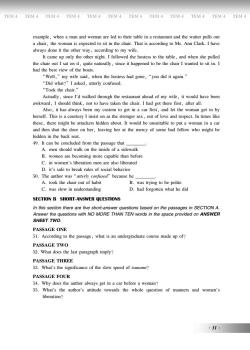
TEM4TEM4TEM4TEM4TEM4TEM4TEM4TEM4TEM4TEM4TEM4TEM4example, when a man and woman are led to theirtable in a restaurant and the waiter pulls outa chair,thewoman is expected to sit inthechair.That is according toMs.AnnClark.I havealwaysdoneittheotherway,accordingtomywife.It came up only the other night. I followed the hostess to the table, and when she pulledthe chair out I sat on it, quite naturally, since it happened to be the chair I wanted to sit in.Ihad thebest view of theboats."Well," my wife said, when the hostess had gone,“you did it again."“Did what?"I asked,utterly confused."Took the chair."Actually,since I'd walked through the restaurant ahead of my wife,it would have beenawkward,I should think,nottohavetakenthe chair.Ihad got therefirst,after all.Also,ithasalways been mycustomto getina carfirst,and letthewoman getinbyherself.This is a courtesyI insist on as the stronger sex, out of love and respect. In times likethese, there might be attackers hidden about. It would be unsuitable to put a woman in a carand then shut the door on her, leaving her at themercy of some bad fellowwho might behidden in the back seat.49.It can be concluded from the passage thatA. men should walk on the inside of a sidewalkB.women are becomingmore capable thanbeforeC. in women's liberation men are also liberatedD. it's safeto break rules of social behavior50.The author was“utterly confused"because heA. took the chair out of habitB. was trying to be politeC. was slow in understandingD. had forgotten what he didSECTIONBSHORT-ANSWERQUESTIONSIn this section thereare five short-answerquestions basedon thepassages in SEcTIONA.AnswerthequestionswithNOMORETHANTENwords inthespaceprovidedonANSWERSHEETTWO.PASSAGE ONE5l.According tothepassage,what is an undergraduate coursemade up of?PASSAGE TWO52.What does the last paragraph imply?PASSAGETHREE53.What's the significance of the slow speed of tsunami?PASSAGEFOUR54.Whydoestheauthor alwaysgetina carbeforea woman?55.What's the author's attitude towards thewhole question of manners and women'sliberation?.31
!"# $ !"# $ !"# $ !"# $ !"# $ !"# $ !"# $ !"# $ !"# $ !"# $ !"# $ !"# $ .F*2:4." 93.+ *2*+ *+/ 912*+ *-.4./ (1 (3.6-(*?4.6+ *-.5(*B-*+(*+/ (3.9*6(.-:B4451B( *)3*6-" (3.912*+ 65.F:.)(./ (1 56(6+ (3.)3*6-%6/ 93*()% '*5C./" B((.-4H )1+0B5./% $%6(,55*0.(1 ?-.*C -B4.51051)6*4?.3*761- LK%%3*/ 01-=1((.+ 93*(3./6/ !"#$%&' + !1&-$!('!3"- 2/"!$%&'! D&$("# #%9$"'&$(%1%.1%)";%#('1$K.&#+%1L5%#$"'&# 2.#%3'&$(%-.##.,%# "&JCE>DAB0/ 0&#+%1$(%L5%#$"'&# +"$(BAGAHC>I0B>CB+'13# "&$(%#-.9%-1';"3%3'&/01234 15336627/ 123324"/5" L$%&))1-/6+= (1 (3.:*55*=." 93*(65*+ B+/.-=-*/B*(.)1B-5.2*/.B: 10) 123324"!6/ L@%Q3*(/1.5(3.4*5(:*-*=-*:3 62:4H) 123324"!78"" LD%Q3*(,5(3.56=+606)*+).10(3.54195:./ 10%$"(+9&) 123324"K/L8 LG%Q3H /1.5(3.*B(31-*49*H5=.(6+ *)*-?.01-.*912*+) LL%Q3*(,5(3.*B(31-,5*((6(B/.(19*-/5(3.9314. RB.5(61+ 102*++.-5*+/ 912.+,5 46?.-*(61+) !#!!
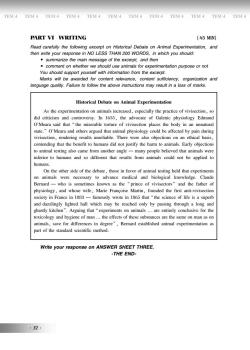
TEM4TEM4TEM4TEM4TEM4TEM4TEM4TEM4TEM4TEM4TEM4TEM4[45 MIN]PART VI WRITINGRead carefully the following excerpt on Historical Debate on Animal Experimentation, andthen write your response in NO LESS THAN20o WORDS, in which you should:summarizethemainmessageoftheexcerpt,andthencommentonwhetherweshoulduseanimalsforexperimentationpurposeornotYoushouldsupportyourselfwithinformationfromtheexcerpt.Marks will be awarded for content relevance,content sufficiency,organization andlanguage quality.Failure to follow the above instructions may result in a loss of marks.HistoricalDebateonAnimalExperimentationAs theexperimentation on animals increased,especiallythepracticeof vivisectionsodid criticism and controversyIn 1655the advocate of Galenic physiology EdmundO'Meara said that"the miserable torture of vivisection places the body in an unnaturalstate."” o'Meara and others argued that animal physiology could be affected by pain duringvivisection,rendering results unreliable. There were also objections on an ethical basis,contending that the benefitto humans did not justify the harm to animals.Earlyobjectionsto animal testing also came from another angle-many people believed that animals wereinferior to humans and so different that results from animals could not be applied tohumans.On the other side of the debate, those in favor of animal testing held that experimentson animals were necessary to advance medical and biological knowledge. ClaudeBernardwho is sometimes known as the"prince of vivisectors"and the father ofphysiology, and whose wife,Marie Frangoise Martin, founded the first anti-vivisectionsociety in France in 1883-—famously wrote in 1865 that“the science of life is a superband dazzlingly lighted hall which may be reached only by passing through a long andghastly kitchen".Arguing that"experiments on animals ... are entirely conclusive for thetoxicology and hygiene of man ... the effects of these substances are the same on man as onanimals,savefordifferencesin degree",Bernard established animal experimentation aspart of the standard scientific method.WriteyourresponseonANSWERSHEETTHREE.-THE END-·32
!"# $ !"# $ !"# $ !"# $ !"# $ !"# $ !"# $ !"# $ !"# $ !"# $ !"# $ !"# $ !"#$ 3% 2#%$%)- "-, #"*# H%.39.1%)5**4 $(%)'**'+"&,%N9%1-$'&I"#$'1"9.*7%2.$%'&0&"6.*CN-%1"6%&$.$"'&8.&3 $(%&+1"$%4'511%#-'&#%"&BA!CJJ>I0BOPPFAH7J8"&+("9(4'5#('5*3Q ! #566.1"R%$(%6."&6%##.,%')$(%%N9%1-$8.&3$(%& ! 9'66%&$'&+(%$(%1+%#('5*35#%.&"6.*# )'1%N-%1"6%&$.$"'&-51-'#%'1&'$ @'5#('5*3#5-'1$4'51#%*)+"$("&)'16.$"'&)1'6 $(%%N9%1-$/ G.1?# +"**2%.+.13%3)'19'&$%&$1%*%;.&9%89'&$%&$#5))"9"%&948'1,.&"R.$"'&.&3 *.&,5.,%L5.*"$4/:."*51%$')'**'+$(%.2';%"&#$159$"'&# 6.4 1%#5*$"&.*'## ')6.1?#/ 7.+-&*.=,:M)A,-)&'2'.<,:"NF)*.<)'-,-.&' &5(3.F:.-62.+(*(61+ 1+ *+62*456+)-.*5./" .5:.)6*44H (3.:-*)(6).1076765.)(61+" 51 /6/ )-6(6)652 *+/ )1+(-17.-5H%'+ $MLL" (3.*/71)*(.10A*4.+6):3H56141=H Y/2B+/ \,V.*-*5*6/ (3*($(3.265.-*?4.(1-(B-.1076765.)(61+ :4*).5(3.?1/H 6+ *+ B++*(B-*4 5(*(.%% \,V.*-**+/ 1(3.-5*-=B./ (3*(*+62*4:3H56141=H )1B4/ ?.*00.)(./ ?H :*6+ /B-6+= 76765.)(61+" -.+/.-6+= -.5B4(5B+-.46*?4.%<3.-.9.-.*451 1?[.)(61+51+ *+ .(36)*4?*565" )1+(.+/6+= (3*((3.?.+.06((1 3B2*+5/6/ +1([B5(60H (3.3*-2(1 *+62*45%Y*-4H 1?[.)(61+5 (1 *+62*4(.5(6+= *451 )*2.0-12*+1(3.-*+=4.# 2*+H :.1:4.?.46.7./ (3*(*+62*459.-. 6+0.-61-(1 3B2*+5*+/ 51 /600.-.+((3*(-.5B4(50-12 *+62*45)1B4/ +1(?.*::46./ (1 3B2*+5% \+ (3.1(3.-56/.10(3./.?*(." (315.6+ 0*71-10*+62*4(.5(6+= 3.4/ (3*(.F:.-62.+(5 1+ *+62*459.-. +.).55*-H (1 */7*+). 2./6)*4*+/ ?6141=6)*4C+194./=.%;4*B/. 8.-+*-/ # 931 65512.(62.5C+19+ *5(3.$ :-6+).1076765.)(1-5% *+/ (3.0*(3.-10 :3H56141=H" *+/ 9315.960." V*-6.U-*+h165.V*-(6+" 01B+/./ (3.06-5(*+(6!76765.)(61+ 51)6.(H 6+ U-*+).6+ $IID # 0*21B54H 9-1(.6+ $IML (3*($(3.5)6.+).10460.65*5B:.-? *+/ /*WW46+=4H 46=3(./ 3*44936)3 2*H ?.-.*)3./ 1+4H ?H :*556+= (3-1B=3 *41+= *+/ =3*5(4H C6()3.+%%&-=B6+= (3*($.F:.-62.+(51+ *+62*45%%%*-.+(6-.4H )1+)4B567.01-(3. (1F6)141=H *+/ 3H=6.+.102*+ %%%(3.00.)(510(3.5.5B?5(*+).5*-.(3.5*2.1+ 2*+ *51+ *+62*45" 5*7.01-/600.-.+).56+ /.=-.% " 8.-+*-/ .5(*?4653./ *+62*4.F:.-62.+(*(61+ *5 :*-(10(3.5(*+/*-/ 5)6.+(606)2.(31/% 2'()#9+:''#%,+.%#+./0123415336654338 ;65330<; !#"!
按次数下载不扣除下载券;
注册用户24小时内重复下载只扣除一次;
顺序:VIP每日次数-->可用次数-->下载券;
- 《综合英语》课程教学资源Ⅳ_48292_课程资源_综合英语Ⅳ_在线教学_第四周_张燕-在线教学-第四周(周四).ppt
- 《综合英语》课程教学资源Ⅳ_48292_课程资源_综合英语Ⅳ_在线教学_第二周_张燕-在线教学-第二周周四.ppt
- 《综合英语》课程教学资源Ⅳ_48292_课程资源_综合英语Ⅳ_在线教学_第一周_张燕-在线教学-第一周.ppt
- 《综合英语》课程教学资源Ⅳ_48291_课程资源_综合英语Ⅳ_unit 1.ppt
- 《综合英语》课程教学资源Ⅳ_48291_课程资源_综合英语Ⅳ_unit 5.ppt
- 《综合英语》课程教学资源Ⅳ_48291_课程资源_综合英语Ⅳ_unit11.ppt
- 《综合英语》课程教学资源Ⅱ_48290_课程资源_综合英语Ⅱ_Unit 12_学生自制课件_Dale Carnegie 1901.ppt
- 《综合英语》课程教学资源Ⅱ_48290_课程资源_综合英语Ⅱ_Unit 12_学生自制课件_Dale Carnegie 1902.pdf
- 《综合英语》课程教学资源Ⅱ_48290_课程资源_综合英语Ⅱ_Unit 12_学生自制课件_Books to share.ppt
- 《综合英语》课程教学资源Ⅱ_48290_课程资源_综合英语Ⅱ_Unit 12_U12 Background & word study.ppt
- 《综合英语》课程教学资源Ⅱ_48290_课程资源_综合英语Ⅱ_Unit 12_U12 Text analysis 1.ppt
- 《综合英语》课程教学资源Ⅱ_48290_课程资源_综合英语Ⅱ_Unit 12_U12 Text analysis 2.ppt
- 《综合英语》课程教学资源Ⅱ_48290_课程资源_综合英语Ⅱ_Unit 10_U10 Background & word study.ppt
- 《综合英语》课程教学资源Ⅱ_48290_课程资源_综合英语Ⅱ_Unit 10_U10 Text analysis1 课堂用.ppt
- 《综合英语》课程教学资源Ⅱ_48290_课程资源_综合英语Ⅱ_Unit 10_U10 Text analysis 2 课堂用.ppt
- 《综合英语》课程教学资源Ⅱ_48290_课程资源_综合英语Ⅱ_Unit 6_U6 Warm-up & Language study 预习课件.ppt
- 《综合英语》课程教学资源Ⅱ_48290_课程资源_综合英语Ⅱ_Unit 6_U6 Warm-up & New words & expressions课堂用.ppt
- 《综合英语》课程教学资源Ⅱ_48290_课程资源_综合英语Ⅱ_Unit 6_U6 Text analysis 课堂用.ppt
- 《综合英语》课程教学资源Ⅱ_48290_课程资源_综合英语Ⅱ_Unit 5_U5 warm-up& word study.ppt
- 《综合英语》课程教学资源Ⅱ_48290_课程资源_综合英语Ⅱ_Unit 5_U5 Structure and text analysis预习课件.ppt
- 《大学英语》课程教学资源(课文原文)第六单元.doc
- 《大学英语读写》课程教学资源(B)Ⅱ_大学英语读写(B)Ⅱ_大学英语读写第二学期课程导读.ppt
- 《大学英语读写》课程教学资源(B)Ⅱ_大学英语读写(B)Ⅱ_Unit 1 text1.ppt
- 《大学英语读写》课程教学资源(B)Ⅱ_第一单元_week 1 preparation_week 1 preparation_》definion of the 1960s.doc
- 《大学英语读写》课程教学资源(B)Ⅱ_第一单元_week 1 preparation_week 1 preparation_mew words of Unit 1_words of Unit 1.ppt
- 《大学英语读写》课程教学资源(B)Ⅱ_第一单元_week 2 book 2 Unit 1 paragraph 1——5_week 2 text 1_week 2 Unit 1 paragraph 1-5.ppt
- 《大学英语读写》课程教学资源(B)Ⅱ_大学英语读写(B)Ⅱ_Unit five.ppt
- 《大学英语读写》课程教学资源(B)Ⅱ_大学英语读写(B)Ⅱ_Unit 4.ppt
- 《大学英语读写》课程教学资源(B)Ⅱ_大学英语读写(B)Ⅱ_Unit one 课件.ppt
- 《大学英语读写》课程教学资源(B)Ⅱ_大学英语读写(B)Ⅱ_大学英语读写导论.ppt
- 《大学英语读写》课程教学资源(B)Ⅱ_大学英语读写(B)Ⅱ_课件_课文+知识点_课件2_U1课文+知识点.ppt
- 《综合英语》课程教学资源Ⅲ_50550_课程资源_综合英语Ⅲ_Unit 3 A Dill Pickle_预习课件_book3-unit3预习课件3.ppt
- 《综合英语》课程教学资源Ⅲ_50550_课程资源_综合英语Ⅲ_Unit 3 A Dill Pickle_预习课件_book3-unit3预习课件2.ppt
- 《综合英语》课程教学资源Ⅲ_50550_课程资源_综合英语Ⅲ_Unit 3 A Dill Pickle_预习课件_book3-unit3预习课件1.ppt
- 《综合英语》课程教学资源Ⅲ_50550_课程资源_综合英语Ⅲ_Unit 3 A Dill Pickle_拓展资料_现代派艺术与文学作品-超短篇.ppt
- 《综合英语》课程教学资源Ⅲ_50550_课程资源_综合英语Ⅲ_Unit 3 A Dill Pickle_背景知识_English 1902 Stream of consciousness.ppt
- 《综合英语》课程教学资源Ⅲ_50550_课程资源_综合英语Ⅲ_Unit 3 A Dill Pickle_背景知识_English 1902 Modernism.ppt
- 《综合英语》课程教学资源Ⅲ_50550_课程资源_综合英语Ⅲ_Unit 3 A Dill Pickle_教学课件_Uni3 教师参考课件.ppt
- 《综合英语》课程教学资源Ⅲ_50550_课程资源_综合英语Ⅲ_Unit 4 Diogenes and Alexander_预习课件_book3-unit 4 预习课件2.ppt
- 《综合英语》课程教学资源Ⅲ_50550_课程资源_综合英语Ⅲ_Unit 4 Diogenes and Alexander_预习课件_book3-unit 4 预习课件1.ppt
